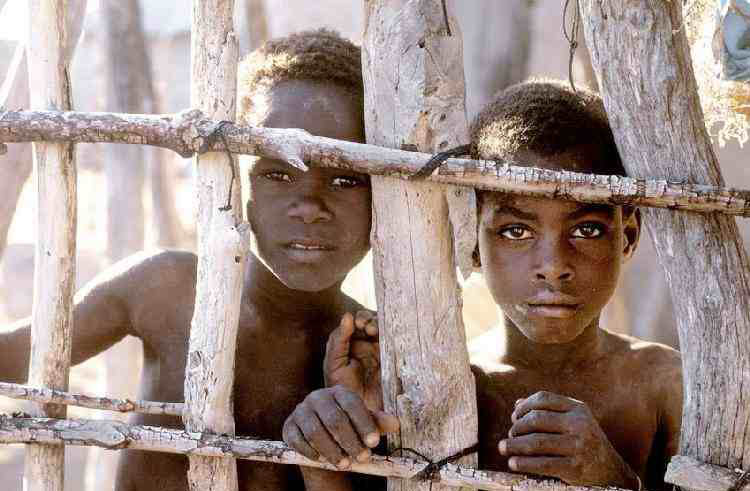Human Predators Stalk Haiti’s Vulnerable Kids
29 Ιανουαρίου 2010
Mia Pean’s heart sank last week when she saw the Toyota pickup truck cruising the debris-cluttered streets of Leogagne, ground zero for the earthquake that has devastated Haiti. Each time the driver saw a child – especially a young teen – he would stick his head out of the window and shout, “Manje, manje,” Creole for “eat.” Pean says she watched the hungry kids, four or five at a time, hop into the back of the pickup, which then disappeared. “I saw the same man again a few days later in Carrefour,” a poor suburb of Port-au-Prince, says Pean. “I asked him, ‘What are you doing with all those children?’ He said, ‘Don’t worry, we’re going to put them in safe homes.’ Then he drove off.”
But Pean, a Haitian-American emergency consultant for the Andrew Young Foundation, doubts that altruism is the motive of the pickup driver, and others like him, who are now prowling Haiti’s streets. The quake that has killed 150,000 people has left thousands of children orphaned, and vulnerable to being preyed upon by child traffickers and Haiti’s shameful tradition of keeping child slaves known as restaveks. “I really fear,” says Pean, “that most of the kids you see being picked up on the streets in Haiti right now are going to become restaveks or victims of sexual trafficking.”
Pean isn’t the only one concerned. Haitian Prime Minister Jean-Max Bellerive on Tuesday expressed the fear that amid the clamor to airlift Haitian orphans out of the devastated country to waiting adoptive parents in the U.S. and Europe, others are being trafficked. The U.N. says it’s on alert to prevent the exploitation of the thousands of Haitian kids who’ve lost or been separated from their parents and who wander aimlessly in search of food, water and shelter. UNICEF, the U.N.’s child advocacy arm, as well as groups like Save the Children and the Red Cross, say they’re registering at-risk kids and setting up shelters exclusively for them. Says one UNICEF official monitoring reports of scenes like the one witnessed by Pean, “Traffickers fish in pools of vulnerability, and we’ve rarely if ever seen one like this.”
The earthquake seems to have shaken more Haitians into vigilance as well – and perhaps, unfortunately, some vigilantism. In the Port-au-Prince neighborhood of Petit Place Cazeu on Wednesday, a crowd of quake survivors living in tents surrounded a pickup truck and beat up the driver, saying he had for several days been trying to kidnap young girls. Bleeding from his nose, mouth and scalp, he managed to get back in his truck and flee. (The angry crowd then threatened to beat up a journalist for even asking questions about child trafficking.)
But the problem remains daunting, and it is exacerbated by the fact that children are not accorded much if any protection under Haitian law or culture. That’s a big reason restaveks are still so prevalent today, not just in Haiti but even in Haitian-American enclaves in the U.S., such as New York and Miami, as Time first reported in 2001. Restavek in Creole means “to stay with,” an innocuous term for a far more sinister practice – children, often given up by their poor Haitian families, “stay with” more affluent families as slaves. And like most slaves, they’re usually subject to physical, emotional and sexual abuse.
Before the earthquake, the Haitian government itself estimated that more than 300,000 Haitian children were living as restaveks in the country, and more of them abroad. Those numbers are likely to grow, says Danielle Romer, a Haitian-American social worker and head of Haitian Support Inc. in Miami, who has long fought the restavek practice – her efforts still often met with denial and even anger by many Haitians. “We were starting to see some improvement before the earthquake, both in terms of getting more of these children into orphanages and missions and in terms of getting some teaching about it out to Haitians,” says Romer. “But I’m afraid the earthquake just opens the box to a scarier situation.”
Joan Conn, executive director of the Jean Cadet Restavek Foundation in Cincinnati, agrees. “We had been building more awareness in Haiti than ever before,” says Conn. “At least people were actually starting to say the word ‘restavek’ out loud for once. But with so many children now abandoned and alone, the task could become even harder.” Conn’s organization – named for Jean-Robert Cadet, a former restavek whose 1998 autobiography, Restavec: From Haitian Slave Child to Middle Class American, lifted the lid on the problem – works to give restaveks refuge in Haiti. In the wake of the earthquake, its staff and volunteers have fanned out across Port-au-Prince and the provinces to watch out for vulnerable kids.
Under prodding from the U.N., the Haitian government last year had finally begun to move against the restavek practice. Last May, some 500 Haitian officials attending a conference with Conn and other child advocates had pledged to make restavek and child-protection a legislative priority. But word has yet to trickle down to the general Haitian population, says Conn, and most restavek recruiters and other child traffickers still feel they have carte blanche to funnel kids to wealthier Haitian families, or abroad.
Worse, says Pean, many of them are exploiting the rush to get Haitian children out of the quake-ravaged country. She recalls the man in the Toyota pickup telling her that “Senators in Washington want us to expedite getting the kids to the U.S.” But, she adds, “the Senators are talking about kids who already have adoption papers ready. These guys are trying to exploit all that confusion.” The situation for Haitian youths was difficult enough before the earthquake. Now, in addition to losing their families, many are under the threat of losing their childhoods as well.
Source: http://www.sott.net/articles/show/202036-Human-Predators-Stalk-Haiti-s-Vulnerable-Kids




